Bitcoin’s Current Correction: At the End of the “Four-Year Cycle,” Government Shutdown Intensifies Liquidity Shock
A Citi report indicates that the liquidation event in the crypto market on October 10 may have damaged investors' risk appetite.
The Citi report points out that the crypto market liquidation on October 10 may have damaged investors' risk appetite.
Written by: He Hao
Source: Wallstreetcn
The crypto market is undergoing a deep correction. Since the historical high at the beginning of October, bitcoin's price has dropped by about 20%. This adjustment is happening at the tail end of bitcoin's "four-year cycle." The liquidity crisis triggered by the ongoing U.S. government shutdown is intensifying the depth and duration of the correction.
The Historical Trajectory of Bitcoin's Four-Year Cycle
The four-year cycle theory of bitcoin is based on its halving mechanism. Every time 210,000 blocks are mined (about four years), the block reward for miners is halved, thereby reducing the supply of new bitcoins. This mechanism creates a predictable supply shock, which has historically triggered cyclical price surges.
Looking back, bitcoin's four-year cycle has shown remarkable regularity:
- After the first halving in November 2012, bitcoin's price soared from $12 to about $1,100.
- After the second halving in July 2016, the price rose from about $650 to nearly $20,000.
- After the third halving in May 2020, the price climbed from about $8,700 to over $67,000.
- In April 2024, bitcoin completed its fourth halving, with the block reward dropping from 6.25 BTC to 3.125 BTC.
Roughly a dozen months after each halving, bitcoin reaches a cyclical peak, followed by a bear market correction. It has now been 18 months since the April 2024 halving event.
However, some research institutions point out that the bitcoin market may be gradually moving away from the typical four-year cycle centered around "halving." Bitwise mentioned in its long-term bitcoin research report that as institutional investors continue to enter the market and spot ETFs provide new demand channels, the market structure is becoming more mature, and price fluctuations may no longer strictly follow the traditional four-year rhythm.
At the same time, the supply-side impact of the 2024 halving has significantly weakened compared to earlier cycles. According to data from Glassnode and Galaxy Research, this halving reduced bitcoin's annualized issuance rate from about 1.7% to about 0.85%. However, since about 19.7 million bitcoins have already been mined (out of a total of 21 million), the proportion of new issuance in the overall supply is now very limited, and its marginal impact on the market is diminishing. This means that market pricing will rely more on the structure of capital inflows (especially from institutions and long-term holders), rather than being mainly driven by changes in new supply.
"Whale" Sell-off: A Typical Feature at the End of the Cycle
Citi's latest report reveals the key driving force behind the current correction: on-chain data shows that bitcoin "whales" (large holders) are gradually reducing their holdings, while the holdings of small "retail" wallets are increasing. This phenomenon is highly consistent with the four-year cycle theory, i.e., at the end of the cycle, smart money usually sells bitcoin to new entrants.
On-chain data shows that since August, whales have cumulatively sold 147,000 bitcoins, worth about $16 billion.
The Citi report points out that the number of addresses holding more than 1,000 bitcoins is declining, while the number of "retail" investors holding less than 1 bitcoin is increasing. Glassnode's holding stratification analysis shows that entities holding more than 10,000 bitcoins are in a clear "distribution" phase, while the group holding 1,000–10,000 is generally neutral, and net buying mainly comes from smaller holders who tend to allocate for the long term.
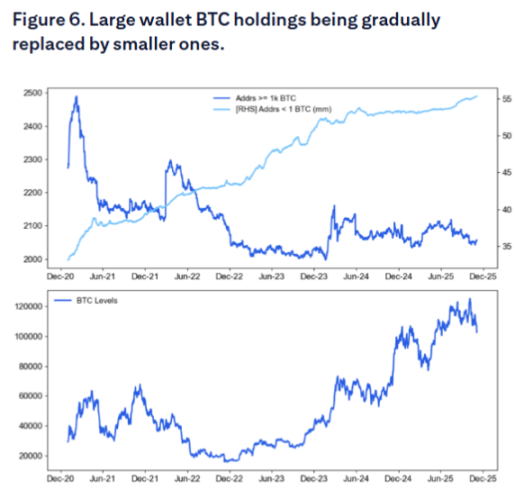
There is a deep logic behind this selling pattern. Almost all long-term holders are currently in profit and are taking large-scale profits. Bitwise's Head of Research in Europe, André Dragosch, points out that these whales "believe in the four-year halving cycle and therefore expect that bitcoin has already reached the peak of this cycle."
CryptoQuant CEO Ki Young Ju points out that the current market structure is different from previous "whales selling to retail" patterns, and is evolving into "old whales transferring chips to new long-term holders (such as institutions, ETFs, and allocation-type buyers)." This means that although selling pressure is still occurring, the nature of the buyers is changing, and price corrections may therefore be milder but last longer.
The Government Shutdown's Liquidity "Vacuum Cleaner"
The more direct catalyst for the current bitcoin correction comes from the liquidity crisis triggered by the U.S. government shutdown. The sharp expansion of the U.S. Treasury General Account (TGA) balance is sucking a large amount of liquidity out of the market, with bitcoin, as a risk asset, bearing the brunt.
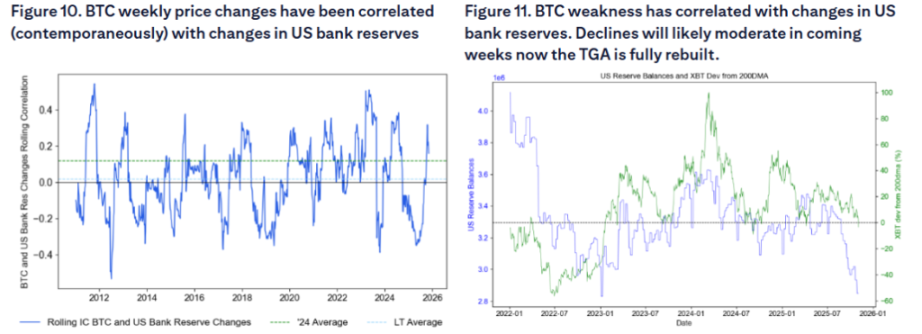
At the end of October 2025, the TGA balance exceeded $1 trillion for the first time, reaching a nearly five-year high since April 2021. In the past few months, the TGA balance has soared from about $300 billion to $1 trillion, draining more than $700 billion in liquidity from the market.
It should be clarified that the increase in the TGA balance is not caused solely by the government shutdown, but is the result of two combined factors:
- First is the shutdown itself: Since the government shutdown on October 1, 2025, the U.S. Treasury has continued to collect funds through taxes and bond issuance, but since Congress has not approved the budget, most government departments are closed and the Treasury cannot spend as planned, so the TGA is "only in, not out."
- Second is the continued impact of large-scale U.S. Treasury issuance. Even during normal government operations, the Treasury replenishes the TGA account through bond issuance, which also drains liquidity from the market.
The impact of this "double drain" mechanism is huge:
According to Federal Reserve official reports and financial institution data, foreign commercial banks' cash assets have dropped to about $1.176 trillion, a significant decline from the July peak. The Fed's total reserves have fallen to $2.8 trillion, the lowest level since early 2021.
The expansion of the TGA balance has triggered widespread tension in the money market. The upper end of the overnight repo rate reached 4.27%, far higher than the Fed's 3.9% excess reserve rate and the 3.75%-4.00% federal funds target range. The SOFR rate has also risen significantly, indicating a clear tightening of market liquidity.
The Citi report particularly emphasizes that cryptocurrencies are "very sensitive" to bank liquidity conditions. Research shows that weekly changes in bitcoin prices are synchronously correlated with changes in U.S. bank reserves, and declines in bank reserves are often accompanied by weak bitcoin performance. This sensitivity makes bitcoin the earliest and most sensitive victim of liquidity tightening.
From a policy perspective, the government shutdown is equivalent to multiple rounds of disguised interest rate hikes. Analysis suggests that the $700 billion in liquidity withdrawn from the market by the U.S. Treasury has a tightening effect comparable to significant monetary policy tightening.
The Fed announced the end of quantitative tightening (QT) at its October meeting. Analysis points out that if it weren't for the liquidity crunch, the Fed might not have announced the end of QT. However, this operation by the Fed will not begin until December.
October 10 "Black Friday" Liquidation Event
The Citi report notes that the "Black Friday" liquidation event on October 10 further damaged market risk appetite. While the futures market is usually a zero-sum game, this liquidation may have impaired the risk-taking capacity of crypto natives and dampened the risk appetite of new potential ETF investors.
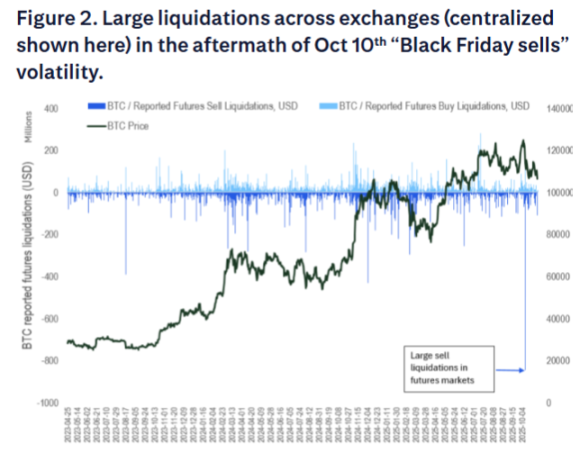
The decline in funding rates also reflects insufficient demand for leverage, indicating overall market sentiment weakness.
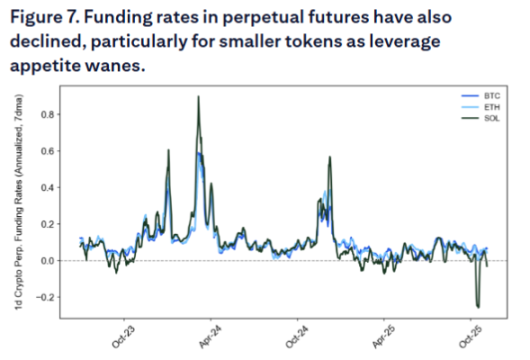
In addition, capital inflows into U.S. spot bitcoin ETFs have dropped significantly in recent weeks, which was unexpected by the market, as ETF capital flows were thought to be relatively immune to the October 10 "Black Friday" liquidation event in the futures and decentralized exchange markets. Inflows into ether ETFs have also slowed significantly.
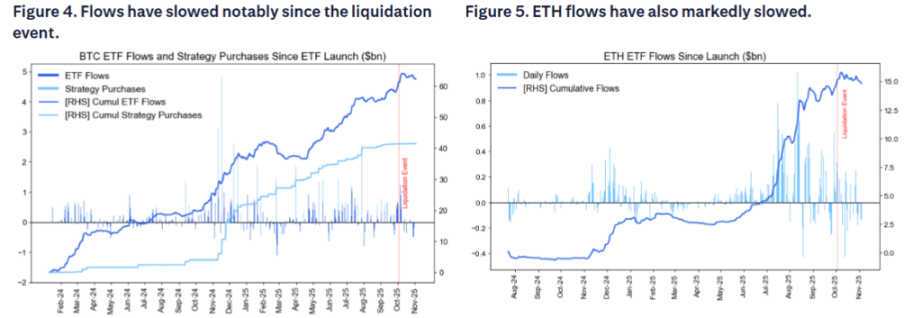
The Citi report also points out that bitcoin's current trading price has fallen below the 200-day moving average, which usually further suppresses demand. Technical analysis shows that even simple moving average rules have helped manage bitcoin investments over the past decade, highlighting the importance of technical indicators in investment strategies.
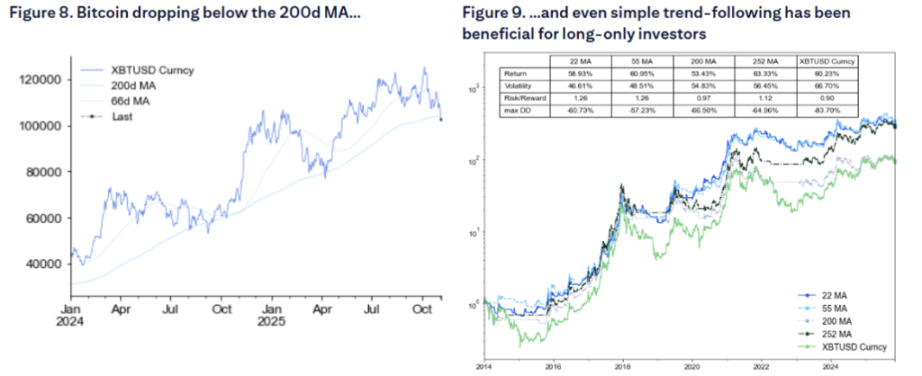
Turning Point in Crisis: Liquidity Release After Government Reopening
Despite the current severity, the root of the crisis is also the key to the market's potential turnaround. Since the government shutdown is the main driver of liquidity tightening, once the shutdown ends, the U.S. Treasury will begin to draw down its huge TGA cash balance, releasing hundreds of billions of dollars in liquidity into the economy.
Previously, Goldman Sachs predicted that the government shutdown was most likely to end around the second week of November, with key pressure points including the salaries of air traffic controllers and airport security staff due on October 28 and November 10—similar disruptions in 2019 ultimately led to the end of that shutdown. Prediction markets show about a 50% chance of the government reopening before mid-November, with less than a 20% chance of dragging past Thanksgiving.
Once the U.S. government restarts, the release of pent-up liquidity could trigger a massive rush into risk assets. This liquidity release could be equivalent to "stealth quantitative easing," a scenario seen in early 2021 when the rapid drawdown of the Treasury's cash balance fueled a sharp rise in the stock market. Once the government reopens, the release of pent-up liquidity coinciding with year-end could drive a surge in bitcoin, small-cap stocks, and almost all non-AI assets that are sensitive to liquidity.
The worse the current situation, the more reserve liquidity will be released in the medium term. The TGA balance is currently close to $1 trillion, and once it starts to be drawn down, the scale of liquidity released will be unprecedented. This sudden return of liquidity could become a catalyst for a strong rebound in risk assets such as bitcoin.
Disclaimer: The content of this article solely reflects the author's opinion and does not represent the platform in any capacity. This article is not intended to serve as a reference for making investment decisions.
You may also like
Trading Strategy: In-depth Review of the Reasons Behind the xUSD Crash
The rule of "high risk, high return" always holds true, but to apply it, you must truly understand the risks involved.

AiCoin Daily Report (November 7)
The “Zeroing Out” of Brother Ma Ji: The High-Leverage Dream of a Serial Entrepreneur Shattered

2025 Digital Asset Treasury Company (DATCo) Annual Report
